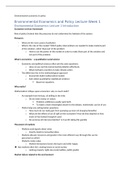College aantekeningen
Environmental Economics and Environmental Policy Lectures
- Instelling
- Wageningen University (WUR)
This Document entails all the obliged lectures as noted in the Course Guide of this course (ENR-20306) teached at the Wageningen University year . Lectures: Andries Richter, Mattijs Smits and Francisco Alpízar
[Meer zien]




